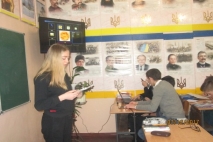Review how to make an interesting English Lesson
Клавдія Міняйло
вчитель англійської мови
Дніпровський науковий техніко-економічний ліцей № 61 «ЕРУДИТ», ДМР
сlaudiaminyailo05@gmail.com
REVIEW HOW TO MAKE AN INTERESTING ENGLISH LESSON
There are no secrets to success. It is the result of preparation, hard work, and learning from failure.
Colin Powell
I try to do my best to teach students, to make my classes interesting and informative, to develop students’ creativity and imagination. The teachers are told how to teach. The aim is helping my pupils integrate their social, emotional and intellectual growth; share, use, understand knowledge; to make better decisions in their personal lives.
The main principle of my system of work is using different kinds of visual aids, multimedia, innovative technologies, music, additional materials, poetry moments, relax. I never forget that each student is a personality. I try not to teach them but to cooperate, to study together and to help each other.
Here are some strategies how to learn English, use English, live with English, enjoy English and you’ll conquer the world and make it better. English for me is motivation, inspiration and desire to succeed in what you do. So, every day, during my teaching, I’ve got a nice opportunity to teach and to learn.
Teaching English is a long process. To my mind a teacher should be a good ‘designer’ of his lessons, he should know what to teach and how to teach for pupils to enjoy English. And I always bear the following, to use one and the same method for a long time is too boring for pupils, they lose their interest in English and learning it. A teacher should be always learning himself not to die as a teacher. Don’t be afraid of experimenting several methods in your class.
- Pair and group work inspire your pupils to a creative work, arise their interest in communicating English.








- The lessons conducted in the form of game a conference, excursion, trip, discussion or TV show are also liked by pupils.



![]()
![]()

- Role-play is one more way of making the lessons more interesting.
- Animal Moves
Name an animal and everyone shows how that animal moves. The game is over when everyone named an animal and the class showed that animal.
- Write your name
With one of your fingers, as a pencil, write your name in the air. Now repeat and ‘write’ with different body parts as your pencil – knee, toe, shoulder, head.
- Roundabout
The pupils make two circles, inner and outer. They are moving like a roundabout and say, for example, what they can (inner circle), what they can’t do (outer circle).
- Singing songs is very useful for our children. It’s one of the best ways of brightening up the English lesson.
![]()


![]()



![]()


![]()


![]()


![]()
Some strategies how to make an interesting English lesson
Following are some research-based strategies for motivating students to learn
- Become a role model for student interest
Deliver your presentations with energy and enthusiasm. As a display of your motivation, your passion motivates your students. Make the course personal, showing why you are interested in the material.
- Get to know your students
You will be able to better tailor your instructions to the students’. Display a strong interest in students’ learning and a faith in their abilities.
- Use examples freely
Many students want to be shown why a concept or technique is useful before they want to study it further. Inform students about how your course prepares students for future opportunities.
- Use a variety of student-active teaching activities
These activities directly engage students in the material and give them opportunities to achieve a level of mastery.
- Teach by discovery
Students find discovering as satisfying through the problem.
- Goals
Be ready to make changes in your life. Stay focused on the positive.
“When it comes to achieving your goals, being positive is so important”, agrees Rosenberg.
“The most effective way to change our beliefs is to create a mental story of success”, Frost says. We need to picture ourselves as we want to be, and we need to talk about it.
- Use Internet in the classroom
The Web is great for research projects, as it enables students to gather detailed information that might otherwise be difficult to find. Keep in mind that searching the Web works best with upper level students. Also, Web research is better for individual rather than group projects, and is easier if each student has access to a computer.
- Give multimedia presentations – or have your students give them
Liven up a traditional class by using a PowerPoint presentation that incorporates photographs, diagrams, sound effects, music or video clips. Consider your high school students develop presentation as a review tool before English tests. Their works may be so good that you will want to use it in future classes!
- Be free with praise and constructive in criticism
- Give students as much control over their own education as possible
Список літератури:
- Загальноєвропейські Рекомендації з мовної освіти: викладання, оцінювання. – К. : Ленвіт, 2004.- 261 с.
- Judith Toack Lanier. Redefining the teacher role//Англійська мова. Усе для репетитора. 3 (39) 2017// Основа. – 2017. - № 3. – С. 8-10
- www.thirteen.org
- www.teachclub.com,Kim Haynes
- Kim Haynes. Use technology//Англійська мова. Все для репетитора. – Основа. – 2017. - № 1.- С. 5-8
- Kuchah, K. and Smith, R. 2011. Pedagogy of autonomy difficult circumstances: Principles from practice’. International Journal of Innovation in Language Learning and Teaching 5/2: 119-139


про публікацію авторської розробки
Додати розробку
